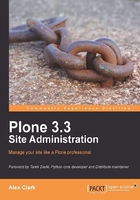
Conventions
In this book, you will find a number of styles of text that distinguish between different kinds of information. Here are some examples of these styles, and an explanation of their meaning.
Code words in text are shown as follows: "If so, just create the directory and then re-run the buildout command."
A block of code is set as follows:
[buildout] extends = buildout.cfg parts += plonesite [plonesite] recipe = collective.recipe.plonesite
Next, we specify that we want the checkout to occur in the src directory (instead of the parts directory, which is the default) by setting the location parameter:
location = src
When we wish to draw your attention to a particular part of a code block, the relevant lines or items are set in bold:
[buildout]
extends = http://dist.plone.org/release/3.3.5/versions.cfg
versions = versions
parts =
zope2
instance
find-links =
http://dist.plone.org/thirdparty/PILwoTk-1.1.6.4.tar.gz
Any command-line input or output is written as follows:
$ buildout –c 01-background-python.cfg
Some of the code lines were too long to fit on one line. In that case, you may see a back slash (\) like this to indicate that the next line is really a part of the current line of the code, for example:
urls=http://dist.plone.org/thirdparty/\ PILwoTk-1.1.6.4.tar.gz
New terms and important words are shown in bold. Words that you see on the screen, in menus or dialog boxes for example, appear in the text like this: "Select the checkbox next to the Plone site object, and click on Delete."
Note
Warnings or important notes appear in a box like this.
Tip
Tips and tricks appear like this.